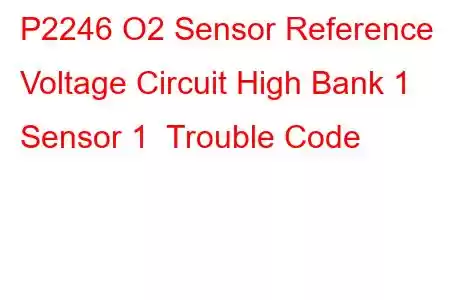P2246 O2 Sensor Reference Voltage Circuit High Bank 1 Sensor 1
OBD-II Trouble Code Technical Description
O2 Sensor Reference Voltage Circuit High Bank 1 Sensor 1
What does P2246 mean?
This diagnostic trouble code (DTC) is a generic powertrain code and applies to many OBD-II vehicles (1996-newer). That may include but is not limited to vehicles from Honda, Ford, Mazda, VW, Mercedes-Benz, Audi, Hyundai, Acura, BMW, etc. Although generic, the exact repair steps may vary depending on year, make, model and powertrain configuration.
A stored code P2246 means that the powertrain control module (PCM) has detected an excessive reference voltage for the upstream O2 sensor for engine bank one. Sensor 1 refers to an upstream sensor and Bank 1 refers to the bank of the engine which does not contain the number one cylinder.
The engine air to fuel ratio for each engine bank is monitored by the PCM using data input from heated exhaust oxygen sensors. Each oxygen sensor is constructed using a zirconium dioxide sensing element situated in the center of a vented steel housing. Tiny electrodes (usually of platinum) attach the sensing element to wire leads in the oxygen sensor harness connector and the connector plugs into the controller area network (CAN) which connects the oxygen sensor wiring harness to the PCM connector.
Each oxygen sensor is threaded (or studded) into an exhaust pipe. It is situated so that the sensing element is near the center of the pipe. As spent exhaust gases exit the combustion chamber (via the exhaust manifold) and continue through the exhaust system (including catalytic converters), they flow over the oxygen sensors. Exhaust gases enter the oxygen sensor through specially designed vent holes in the steel housing and swirl around the sensing element. Swirling ambient air is drawn through wire lead cavities in the sensor housing where they fill a tiny chamber in the middle. The air (in the tiny chamber) is then heated. This forces the oxygen ions to produce energy that is recognized by the PCM as voltage.
Variations between the number of oxygen ions in ambient air (drawn into the O2 sensor), and the number of oxygen molecules in the exhaust, cause the oxygen ions inside the O2 sensor to bounce from one platinum layer to the other, very swiftly and repetitively. As the surging oxygen ions shift between platinum layers, variations in oxygen sensor output voltage occur. The PCM sees these variations in oxygen sensor output voltage as changes in exhaust oxygen concentration. Voltage signal outputs from the oxygen sensors are lower when more oxygen is present in the exhaust (lean condition) and higher when less oxygen is present in the exhaust (rich condition).
If the PCM detects a high electrical value in oxygen sensor reference voltage, a code P2246 will be stored and a malfunction indicator lamp (MIL) may be illuminated. Most vehicles will require multiple ignition cycles (with a failure) for MIL illumination.
A typical oxygen O2 sensor:
What is the severity of this DTC?
An excessive voltage in the O2 sensor reference voltage circuit may lead to diminished fuel efficiency and a reduction in engine performance. A code P2246 should be categorized as severe and rectified as quickly as possible.
What are some of the symptoms of the code?
Symptoms of a P2246 trouble code may include:
Diminished fuel efficiency Reduced engine performance Stored misfire codes or lean/rich exhaust codes Service engine soon lamp illuminationWhat are some of the common causes of the code?
Causes for this code may include:
Blown O2 sensor fuse Defective oxygen sensor/s Burnt, chafed, broken, or disconnected wiring and/or connectorsWhat are some P2246 troubleshooting steps?
You will need a diagnostic scanner, a digital volt/ohmmeter (DVOM), and a source of reliable vehicle information
Read: 20


